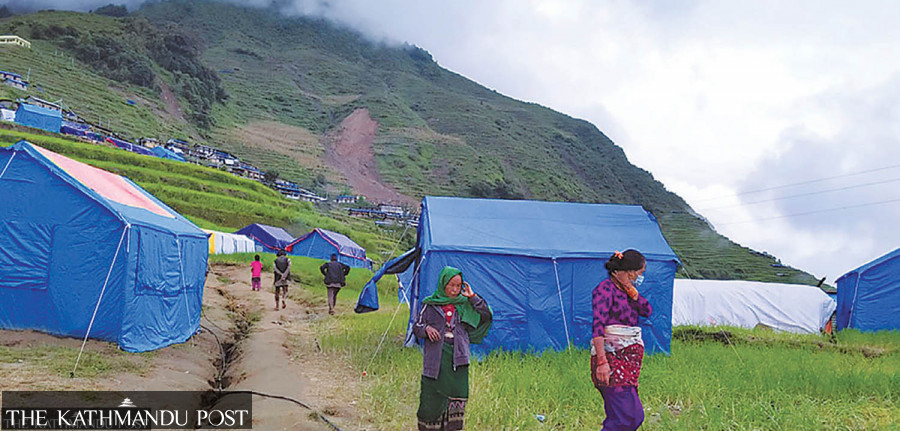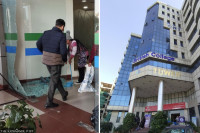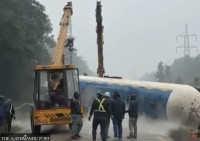National
Two years after disasters, displaced families are still living in makeshift settlements
In 2020, a provincial ministry paid 26 times more in helicopter fares than what it spent on relief for Sindhupalchok flood and landslide victims.
Arjun Poudel
In the monsoon of 2020, at least 11 people were killed and hundreds displaced in floods and landslides triggered by incessant rains in ward 1 of Jugal Rural Municipality in
Sindhupalchok. At least 38 people were unaccounted for.
The Ministry of Internal Affairs and Law of Bagmati Province swung into action. It used the Nepal Army’s helicopters 12 times and another chopper belonging to a private company three times to distribute relief materials, including rice, pulses and medicines.
Now, a new report by the Office of the Auditor General, which keeps track of government expenses, has made a startling revelation.
The ministry spent a total of Rs2.868 million to distribute rice, pulses and medicines worth Rs1,11,000 to the displaced people.
According to the report, made public on Wednesday, the ministry spent Rs2.568 million to pay the Army helicopter for using it 12 times and Rs300,000 to a private company for using its chopper three times.
The amount paid by the provincial ministry in chopper fares is 26 times the worth of relief materials.
“This kind of unproductive expenditure should be controlled,” states the report.
Over 700 people of 209 households from the rural municipality who were displaced by the disaster have still been living in makeshift shelters, nearly two years after the incident.
While its extravagant expenditures have been reported by the auditor general’s report, the government promise of providing compensation remains unfulfilled.
The government has decided to provide Rs500,000 to each displaced family from the mountain region, Rs400,000 each in the hill region and Rs300,000 each to families of the Tarai region for the reconstruction of their demolished houses. Every displaced family was supposed to receive Rs50,000 for immediate settlement.
If the area is unfit to reside, an additional Rs300,000 was announced.
But no one from Jugal Rural Municipality received the relief amount decided by the government. Nor has anyone been shifted to new homes.
“Rs25,000 was provided to each family displaced by the disaster in immediate relief,” Lok Bahadur BK, chief administrative officer at the rural municipality, told the Post over the phone from Sindhupalchok. “Some people who constructed temporary shelters also got an additional Rs25,000 but most of them have not.”
Victims have been deprived of help not because the government lacked the resources but due to mismanagement and lack of coordination between the agencies concerned.
Officials at the National Disaster Risk Reduction and Management Authority under the Ministry of Home Affairs said that the Prime Minister National Relief Fund has over Rs3.5 billion in its accounts, the Ministry of Home Affairs has over Rs1 billion, the District Disaster Relief Fund has over Rs1 billion and the Provincial Disaster Relief Fund has over Rs700 million.
Every year the government allocates additional funds for disaster management.
Dijan Bhattarai, spokesperson for the National Disaster Risk Reduction and Management Authority, said his office has developed a system to prevent the misuse of funds and promote accountability. “But there is a problem in data collection, due to which many victims have been deprived of relief amounts,” he said.
The authority said that 6,721 households from 34 districts have been displaced in the last two years in disasters such as landslides, floods and fires. The authority is yet to receive the list of victims and those displaced in the 43 districts.
Of the total displaced families, 2,493 have been listed as beneficiaries. Some have received first and second instalments of the relief amount but none have received the final instalment, according to Bhim Raj Basnet, a section officer at the authority.
But none of the people from Jugal Rural Municipality have received the relief amount, nor have the authorities concerned signed that agreement with the victims to provide the relief amount, according to BK.
“We are not even sure if the land where the victims have been residing is fit for human settlement,” BK said. “We at the local level do not have the expertise to carry out geographical study and the federal government has not yet given the report.”
Construction of houses cannot be started without confirmation whether the land is fit for human settlement.
According to BK, a non-governmental agency has constructed 68 houses for victims but they are yet to be handed over to the respective families.
“Our rural municipality has prepared a detailed project report for the settlement, but without the geographical study report, we are unable to make a decision,” said a local government official asking not to be named.
Experts say that victims are not getting proper attention due to lack of coordination among the agencies under the three tiers of government.
“Agencies under provincial and local governments lack trained human resources,” said Santona Devkota, a disaster risk reduction trainer. “The victims are bearing the additional brunt of the apathy of the agencies.”




 8.12°C Kathmandu
8.12°C Kathmandu













%20(1).jpg&w=300&height=200)

